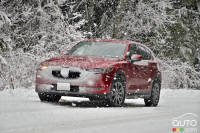Every new Formula 1 car feature a stepped nose with the noticeable exception of the McLaren-Mercedes MP4-27.
Lotus' technical director James Allison explained that driver safety was the main reason behind the stepped nose.
“For years you will gradually noticed that the height of the nose has been coming up and up," Allison said.
"The reason for that is that there is more downforce if you raise the bodywork at the front of the car. But in case of a T-bone crash, the tip of the nose could be so high that it exceeds the height of the cockpit of the other car. So for this year we agreed that the tips of the noses all had to be lowered by a considerable amount. But the rule itself doesn't require the front of the car to be lower, it only requires the tip of the nose to be lowered,” Allison added.
Therefore the engineers designed the stepped nose.
In his latest blog posted on Scarbsf1, Craig Scarborough explains how the McLaren team managed to design a car without a stepped nose, writing that the MP4-27 chassis in side profile shows that the family history of low noses has greatly helped the designers.
“The dashboard bulkhead is maybe just 3 cm higher than the cockpit padding (which is 55 cm high), the chassis top then curves downwards towards the front wheels. By the point of the front (A-A) bulkhead the top is lower than 55cm, may be as low as 5cm below the maximum height. When compared to the maximum heights (the dotted line on the drawing), its clear this is a very low nose overall,” Scarborough wrote.
“This creates less space under the raised nose, but the team's snow plough device under the nose works aggressively as a turning vane, so perhaps the team don’t need the higher chassis to get the correct airflow to the side pods leading edge. McLaren also find the lower nose provides the classic vehicle dynamics benefits of a low CofG (centre of gravity) and a less extreme front suspension geometry. This trade off works for McLaren and goes to prove not everything in F1 has to be a compromise in search of aero advantage.”
Click on this link to read Craig Scarborough's detailed analysis of the new McLaren MP4-27.
Lotus' technical director James Allison explained that driver safety was the main reason behind the stepped nose.
“For years you will gradually noticed that the height of the nose has been coming up and up," Allison said.
 |
| Photo: Ferrari |
"The reason for that is that there is more downforce if you raise the bodywork at the front of the car. But in case of a T-bone crash, the tip of the nose could be so high that it exceeds the height of the cockpit of the other car. So for this year we agreed that the tips of the noses all had to be lowered by a considerable amount. But the rule itself doesn't require the front of the car to be lower, it only requires the tip of the nose to be lowered,” Allison added.
Therefore the engineers designed the stepped nose.
In his latest blog posted on Scarbsf1, Craig Scarborough explains how the McLaren team managed to design a car without a stepped nose, writing that the MP4-27 chassis in side profile shows that the family history of low noses has greatly helped the designers.
 |
“The dashboard bulkhead is maybe just 3 cm higher than the cockpit padding (which is 55 cm high), the chassis top then curves downwards towards the front wheels. By the point of the front (A-A) bulkhead the top is lower than 55cm, may be as low as 5cm below the maximum height. When compared to the maximum heights (the dotted line on the drawing), its clear this is a very low nose overall,” Scarborough wrote.
“This creates less space under the raised nose, but the team's snow plough device under the nose works aggressively as a turning vane, so perhaps the team don’t need the higher chassis to get the correct airflow to the side pods leading edge. McLaren also find the lower nose provides the classic vehicle dynamics benefits of a low CofG (centre of gravity) and a less extreme front suspension geometry. This trade off works for McLaren and goes to prove not everything in F1 has to be a compromise in search of aero advantage.”
Click on this link to read Craig Scarborough's detailed analysis of the new McLaren MP4-27.
 |
| The lower nose of the McLaren. (Photo: McLaren) |
 |
| The higher nose of the Ferrari. Note that the photo was flopped so it is in a same angle as the McLaren. (Photo: Ferrari) |




















